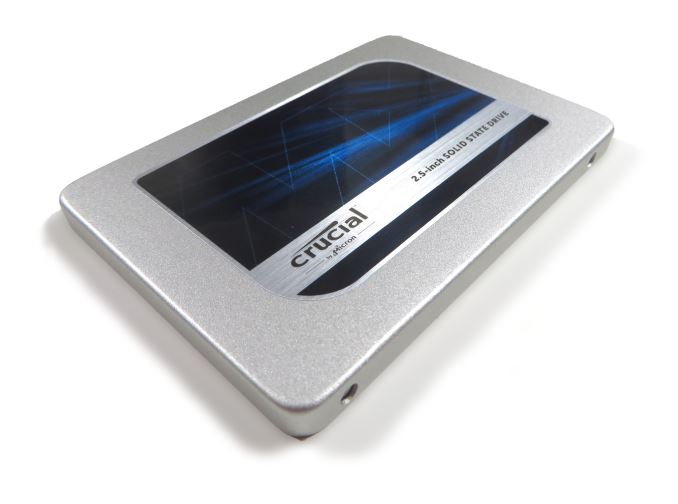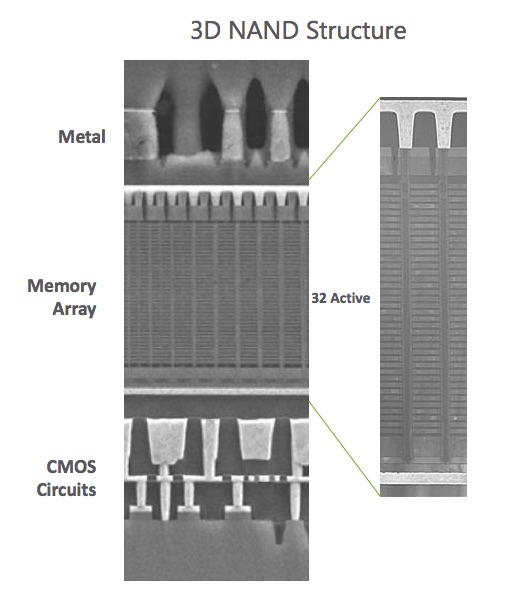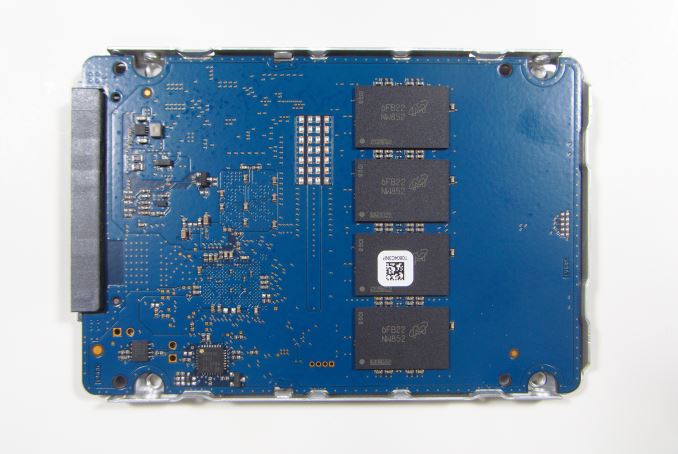The Crucial MX300 750GB SSD Review: Micron's 3D NAND Arrives
by Billy Tallis on June 14, 2016 9:00 AM EST
Micron is the second company to the 3D NAND flash milestone, with today's release of the Crucial MX300 750GB Limited Edition. This follows on from two years ago when Samsung became the first manufacturer to ship SSDs with 3D NAND flash, the 850 Pro - a drive launched as a flagship high end drive and remains the fastest consumer SATA drive today. By contrast, the Crucial MX300 is intended to be a mainstream affordable SSD based on 3D TLC NAND, making the MX300 more of a direct competitor to the 850 Evo.
Micron's strategy for transitioning to 3D NAND is quite different from the path that Samsung took. Similar to other projects, Micron is once more partnered with Intel to produce this generation of flash memory, and their 3D NAND is different compared to Samsung in several ways. While the rest of the industry chose to combine the 3D NAND transition with a switch from a floating gate memory cell to a charge trap design, Intel and Micron's 3D NAND is still a floating gate design, making the end-point a 'simpler' two-step process. As a result, the capacity is also quite different: Samsung's 3D NAND debuted with a 32-layer but small 86Gb MLC die and 128Gb TLC, later followed up with a 128Gb MLC, whereas the Intel/Micron first effort on 32-layer 3D NAND is an MLC part with a capacity of 256Gb and a TLC part with 384Gb, making for a much larger die. While Samsung has continued to develop planar NAND alongside their 3D NAND and recently reintroduced planar NAND to their retail SSD family with the 750 EVO, Micron is committed to going all-3D with new products. To be clear however, Micron's existing planar NAND products won't be going away quickly (especially in the enterprise market).
The Crucial MX300 750GB
The MX300 was first made official at a Micron enterprise storage event with a release planned for April/early Q2. While the launch of the full range of drives was pushed back to allow for a new firmware revision with improved performance to go through a QA cycle, Micron is sticking with the original plan of first launching a limited edition single 750GB capacity, with the full range of capacities and M.2 versions to fill in over the rest of the year. With seven extra weeks of firmware work behind them, supplies of the 750GB MX300 may not be as limited as they would have been for an April launch, but availability could be temporarily constrained as the drives with the updated firmware make their way through the supply chain. Despite this, we also expect that a tight supply of the 3D TLC was a contributing factor in a staggered release, and as a result we start with the Limited Edition first.
750GB is not a typical capacity for a SSD, but the 384Gb (48GB) die capacity of Micron's 3D TLC makes it hard to hit the usual power of two drive capacity points without having a much larger overprovisioning ratio than is typical of a consumer drive. Instead, the MX300 line will probably be the first time we see TLC clearly resulting in an increase of capacity relative to MLC drives across the full range of products, rather than just offering a lower price per GB (and one extra capacity at the high end). Micron hasn't nailed down the final specifications for the other capacities of MX300, but we do know that the smallest drive will use six dies. This will give it a raw capacity of 288GB and the usable capacity may be around 275GB rather than something in the 240-256GB range. The largest (and last to launch) capacity will be in the neighborhood of 2TB. The 750GB model uses sixteen dies arranged in eight packages of two dies each for a raw capacity of 768GB.
In the past, when NAND transitions to a smaller lithography node and a larger die capacity, the reduction in die count has caused a decrease in available parallelism and thus lower performance for drives of the same capacity. Micron is offsetting this by partitioning their 3D NAND into a four plane design, where 128Gb planar flash chips are at most two plane designs. This allows for almost as many commands to be processed simultaneously by the 3D TLC, but will also lead to somewhat higher contention on the link between the controller and the flash.
| Crucial MX Series Specifications | ||||
| Capacity | MX300 750GB | MX200 500GB | MX200 1TB | |
| Form Factors | 2.5" | 2.5", mSATA, M.2 | 2.5" | |
| Controller | Marvell 88SS1074 | Marvell 88SS9189 | ||
| NAND | Micron 384Gbit 32-layer 3D TLC |
Micron 16nm 128Gbit MLC |
||
| DRAM | 512MB | 512MB | 1GB | |
| Sequential Read | 530MB/s | 555MB/s | 555MB/s | |
| Sequential Write | 510MB/s | 500MB/s | 500MB/s | |
| 4KB Random Read | 92K IOPS | 100K IOPS | 100K IOPS | |
| 4KB Random Write | 83K IOPS | 87K IOPS | 87K IOPS | |
| Dynamic Write Acceleration | Yes | Yes (mSATA and M.2 models only) | No | |
| DevSleep Power | 4mW | 2mW | 2mW | |
| Slumber Power | 75mW | 100mW | 100mW | |
| Max Power | 5.2W | 4.7W | 5.2W | |
| Encryption | TCG Opal 2.0 & IEEE-1667 (eDrive) | |||
| Endurance | 220TB | 160TB | 320TB | |
| Warranty | Three years | |||
| Price | $199.99 (MSRP) | $139.00 | $269.94 | |
Aside from adopting 3D TLC and upgrading to the latest in Marvell's long line of SATA SSD controllers, the MX300 offers all the usual features of the MX series: encryption support, SLC caching, partial power loss protection and a three year warranty. Performance and endurance specifications are down slightly from the MX200 due to the new hardware, but are still fine for a mainstream SATA SSD. The final decisions about overprovisioning for the other capacity models could mean they will have better endurance ratings than the MX200 of comparable capacity.
From the exterior the MX300 appears virtually identical to a MX200. Opening it up to look at the PCB, we see a full size circuit board with plenty of room for more NAND, but Micron won't actually need more than the 8 packages in this drive for even the largest 2TB class model. This 750GB drive stacks just two dies per package; a 2TB class drive would need at most six dies per package, but stacking 8 or 16 dies per package is common when dealing with smaller NAND chips and especially smaller form factors. The pads for the power loss protection capacitors are almost all populated.
The 750GB Crucial MX300 comes with a MSRP of $199.99. On a price per GB basis, this puts it on par with the current actual retail prices for the MX200 and we expect competition can drive the MX300 price down further. It will probably take up position near the top of the budget planar TLC segment of the market and be cheaper than all but the best sale prices on MLC drives. So while at first glance the MX300 might appear to be the natural match against the 850 EVO, Micron is clearly aiming lower in price.
In addition to the Crucial MX200 and 3D TLC based 850 EVO, the MX300 will compete against the top performing planar TLC drives like the SanDisk X400, which is based on the same Marvell 88SS1074 controller used in the MX300.
| AnandTech 2015 SSD Test System | |
| CPU | Intel Core i7-4770K running at 3.5GHz (Turbo & EIST enabled, C-states disabled) |
| Motherboard | ASUS Z97 Pro (BIOS 2701) |
| Chipset | Intel Z97 |
| Memory | Corsair Vengeance DDR3-1866 2x8GB (9-10-9-27 2T) |
| Graphics | Intel HD Graphics 4600 |
| Desktop Resolution | 1920 x 1200 |
| OS | Windows 8.1 x64 |
- Thanks to Intel for the Core i7-4770K CPU
- Thanks to ASUS for the Z97 Deluxe motherboard
- Thanks to Corsair for the Vengeance 16GB DDR3-1866 DRAM kit, RM750 power supply, Carbide 200R case, and Hydro H60 CPU cooler













85 Comments
View All Comments
Lonyo - Wednesday, June 15, 2016 - link
Um, the conclusion is entirely negative. Read the conclusion? It's slow, but not as slow as planar TLC drives. It's inexpensive, but not super cheap. It's a generation "above" in naming of the MX200, but is slower. It has to compete on price because it can't compete on performance. It has an acute weakness in random reads.The main strengths are that it's fairly power efficient.
rtho782 - Tuesday, June 14, 2016 - link
Meh, another SSD to compete on price. They have really become commodities!cknobman - Tuesday, June 14, 2016 - link
Not cheaper.Slower.
Uses more power.
No improvement on endurance.
Am I missing anything major here?
I just dont see anything that is purchase worthy here.
azazel1024 - Tuesday, June 14, 2016 - link
If you need >512GB, but don't NEED 1TB and can't justify the price of a 1TB drive.I need to, sadly, buy a new SSD soon and I've been going back and forth between MLC and TLC. My issue is that my budget is extremely limited right now, but I also can't wait a whole lot longer.
The 240/256GB TLC drives just seem to have shite for performance once their SLC caches are filled, and their random read performances are nothing to write home about either. They also tend to have small SLC caches, which increases the likelihood of hitting the cache limit and near full drive performance is especially bad on most of them and I have about 130GB of data I need to transfer off a 120 and a 60GB SSD to it to run one SSD boot drive. 480/512GB TLC drives at around $110-120 are a bit out of my price range (yes, my budget is THAT limited), but it would keep utilized capacity fairly low.
240/256GB MLC drives on the other hand tend to have much better performance, especially as the drive fills up, except the MX200 :-(. Which means in the 240-256GB capacity range, an MX200 isn't much of an option for me. Right now I am looking at a PNY 2211 240GB drive as it seems to be a good blend of price and performance, especially performance once the drive is pretty highly utilized, and I have to face the fact that I might only have 130GB of data to move to the drive right now, but I am sure drive utilization will creep up to 150, 160, 170, 180GB given a year or two (I have a 5.4GiB RAID0 array for bulk storage of 2x3TB drives, but applications aren't getting smaller, even if I stay good on keeping only a few games loaded on the SSD at a time).
Sadly MLC 480/512GB are just well outside my price range right now.
What would be nice is seeing m.2 PCI-e based drives that aren't such a huge jump in $ per GB.
DanNeely - Tuesday, June 14, 2016 - link
While TLC drives do slow down a lot once the SLC cache is exhausted, unless you're doing video editing, batch processing of media files, etc sustained multi-gigabyte writes tend to be very uncommon in the consumer market. SLC caches are used because they're large enough to handle normal use. You really need to be pushing a lot of data at once to exhaust them.jabber - Tuesday, June 14, 2016 - link
I've tried cloning a existing build to the TLC type SSDs (I often will build a machine using a old 64GB SSD then clone it over when the new larger SSD arrives) and the write speeds can drop below 40MBps after about 2 minutes of cloning. We are talking about mainstream SSDs with USB2.0 levels of performance. Even a 5400 RPM HDD will do better.Billy Tallis - Tuesday, June 14, 2016 - link
Our sequential write test runs for three minutes at each queue depth. The slowest 3-minute average we've recorded at any queue depth was 61MB/s. For your drive cloning to be running at only 40MB/s after a mere two minutes, there has to be some other bottleneck. Your software is probably preventing the copy from proceeding at full speed, such as by alternating reading from the source drive and writing to the destination.jabber - Tuesday, June 14, 2016 - link
I said about 2 minutes. I don't actually have an exact record as I wasn't writing an article or review but let's say very soon after starting the cloning the performance dropped to a 'unacceptable' level. Anything below 200MBps write in a 2016 SSD should be classed as unacceptable. By the way it was a BX200 SSD.vladx - Tuesday, June 14, 2016 - link
Yes, most TLC drives are enough for consumer drives. In fact, I'd bet my 840 EVO still kicks this MX300's ass.Byte - Tuesday, June 14, 2016 - link
Truth be told I bet the 830 might still beat it. I put my 830 in my new 4.5GHz skylake system and it was still blazing fast. Put in a m.2 950pro and can't really even tell a difference. Now the low end stuff like Sandisk SSD Plus, you can actually tell its slower at everything.